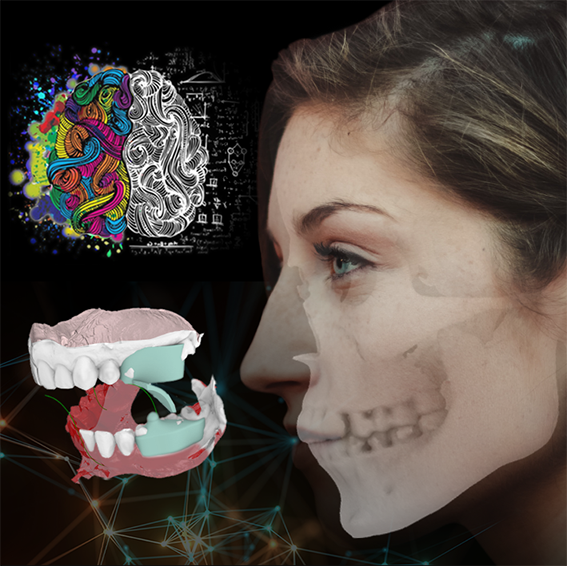THE VALUE OF RESEARCH, THE POWER OF INNOVATION...
PUT THE SPOTLIGHT ON YOUR PROJECT!
The Research Agorà is the area dedicated to international Research Projects inside the International CAE Conference and Exhibition. It’s a full exhibition square located in the heart of the event where enterprise and university researchers disseminate the concepts and the results of their projects. Already in its seventh edition, the Research Agorà hosts many innovative international projects every year, especially those co-funded by the EU and developed through outstanding and prestigious partnerships.
This year’s conference will focus on digital transformation, making it an ideal platform to showcase the numerous research projects that are addressing this challenge across distinct sectors and in many different environments.
Don’t miss the opportunity to be part of this valuable window onto the future of science and technology!
SYNCH - A SYnaptically connected brain-silicon Neural Closed-loop Hybrid system
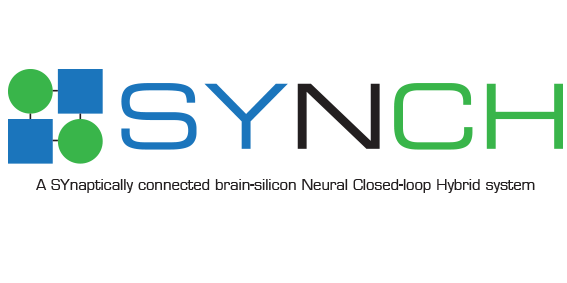
The brain, with its remarkable computational properties, provides animals with capabilities of physical autonomy, interaction and adaptation that are unmatched by any artificial system. The brain is a complex network that has evolved to optimize processing of real-world inputs by relying on event-based signaling and self-reorganizing connectivity. Spikes (the events) are transmitted between neurons through synapses which undergo continuous ‘birth’-‘death’ and adjustment, reconfiguring brain circuits and adapting processing to ever changing inputs. The scientific and technological objective of the project is to create a hybrid system where a neural network in the brain of a living animal (BNN) and a silicon neural network of spiking neurons on a chip (SNN) are interconnected by neuromorphic synapses, thus enabling co-evolution of connectivity and co- processing of information of the two networks
Consortium: • UNIVERSITY OF PADOVA • UNIVERSITY OF SOUTHAMPTON • TECHNISCHE UNIVERSITAET DRESDEN • TECHNISCHE UNIVERSITAET GRAZ • BARILAN UNIVERSITY • aiCTX AG • ArCInstruments • ENGINSOFT SPA
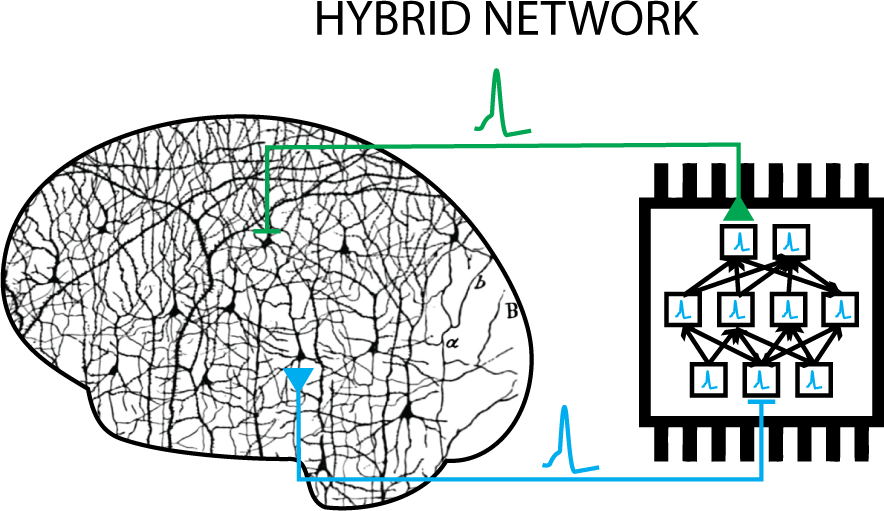
Visit the project web site
POP - Performance Optimisation and Productivity

POP is helping developers and users of computationally intensive parallel programs to accelerate their execution, and thus enable them to address bigger problems in less time and at minimum cost. HPC experts bring POP services free of charge to commercial and public organisations within the EU
Consortium: • BSC Barcelona Supercomputing Center • HLRS High Performance Computing Center Stuttgart • IT4I IT4Innovations National Supercomputing Center • Juelich Supercomputing Centre • RWTH Rheinisch-Westfalische Tecnische Hochscule Aachen • Teratec • UVSQ Université de Versailles St-Quentin-en-Yvelines LI-PaRAD Laboratory

Visit the project web site
WeldGalaxy - Digital Dynamic Knowledge Platform for Welding in Manufacturing Industries

WeldGalaxy project develops a highly visible and transparent knowledge based B2B online platform that brings together global buyers and EU sellers (manufacturers/suppliers/distributors/service providers) of welding equipment and consumables, along with accessories and services. Based on EKON's flagship Dynamic Knowledge Management platform, a group of 11 European partners is driving the DKM platform to novel knowledge & marketplace ecosystem that will highly improve both customer experience and visibility in the welding domain.
The project integrates innovative services based on state-of-the-art technologies such as AI Chatbot, an advanced dynamic Knowledge-Based Engineering (KBE) tool which utilizes intelligent welding rules for the users, Analytics, Simulations and secure automatic tender processes, based on blockchain technologies. From the data aspect, we are harnessing large data-sets of welding knowledge, facilitating and supporting 3rd party projects through open-innovation competitions. The WeldGalaxy B2B platform will underpin progress in endeavours to enhance the visibility of EU’s welding products, prototypes and services to global users via enhanced digital marketing strategies, provide innovative web-based services to boost EU market share and competitiveness, and enable plug and produce digital manufacturing of the right equipment to specified customers/end-users requirements and regulatory compliance.
Consortium: • TWI Limited • Fundingbox Accelerator Sp z o.o. • LULEA TEKNISKA UNIVERSITET • EKON MODELING SOFWARE SYSTEMS • ROMSOFT • FLOWPHYS AS • TECHNOVATIVE SOLUTIONS • ARTEEVO TECHNOLOGIES • AEONX AI • UNIVERSITY OF LEICESTER • UNIVERSIDAD POLITECNICA DE MADRID

Visit the project web site
THE QUEST FOR THE NEXT GENERATION ADAS VIRTUAL TESTING SIMULATION FRAMEWORK

ADAS Systems are a reality of the new generation vehicles, but experts of the Industry advise that billions of kilometers must be covered by autonomous agents to achieve the super-human driving level. Covering such distance to train and to prove the functional safety of the agent may require centuries, alternative approaches, such as virtual testing, are a necessity. Two major problems we are tackling are how to simulate typical ADAS sensors in a realtime rendering environment and to easily connect together into a simulation loop various simulation nodes from independent suppliers. In addition, we also have an procedural 3D driving environment modeling pipeline under development, the pipeline includes interactions with major HD navigation maps databases and GIS terrain data. For what concerns the virtual sensors, we are presenting a beta version of our render engine called “Midgard” that we have used to equipe a statical driving simulator and into which we have simulated to ideal ADAS cameras and the output is streamed in realtime into Nvidia Xavier board, on the Nvidia board an ADAS localization SW stack is implemented and elaborating in realtime the video stream from the 2 vehicle cameras. With respect the simulation network, OEMs are not new to simulation and strive to integrate the different third-party software to complete Simulation System: graphical engines, traffic simulators, vehicle dynamics solvers, etc., must cooperate in a distributed computational environment. The exhibited framework tackles the problem of shared communication and serialization, automatic configuration and content distribution, and software orchestration in a purely distributed environment where HIL systems integration (e.g. car ECUs, nVidia DRIVE AGX) is fundamental.
Consortium: • EnginSoft • LHP Europe • V2R • Trentino Sviluppo • University of Trento • University of Verona • Concurrent Engineering
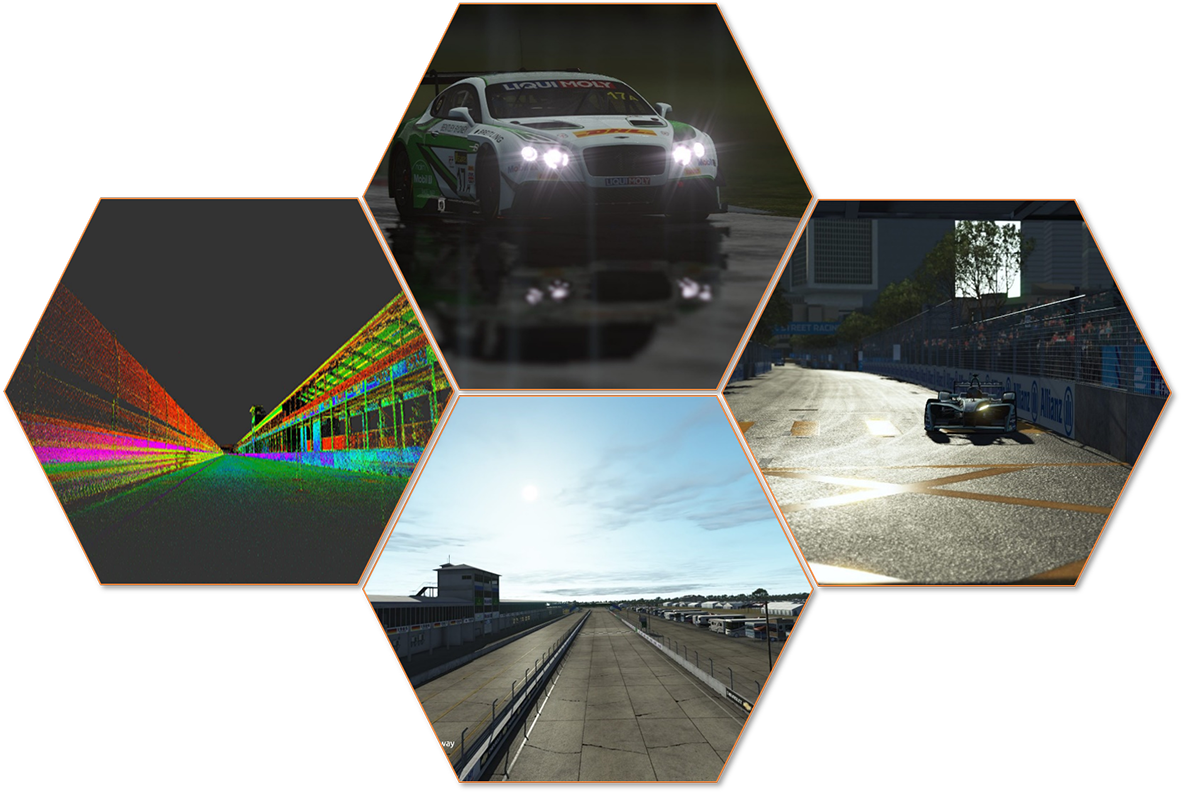
Visit the project web site
QUIET - QUalifying and Implementing a user-centric designed and EfficienT electric vehicle

QUIET aims to develop an improved and energy efficient electric vehicle with increased driving range. It is achieved by exploiting the synergies of a user-centric design with enhanced passenger comfort, lightweight materials with enhanced thermal insulation, and optimized vehicle energy management.
Consortium: • AIT AUSTRIAN INSTITUTE OF TECHNOLOGY • HONDA R&D EUROPE • AVL QPUNKT • VENTREX AUTOMOTIVE • SVEUCILISTE U ZAGREBU, FAKULTET STROJARSTVA I BRODOGRADNJE • FRAUNHOFER GESELLSCHAFT ZUR FOERDERUNG DER ANGEWANDTEN FORSCHUNG E.V. • ATT ADVANCED THERMAL TECHNOLOGIES • RUBITHERM TECHNOLOGIES • SEATTEC SITZTECHNIK • OBRIST ENGINEERING • JRC - JOINT RESEARCH CENTRE - EUROPEAN COMMISSION

Visit the project web site
FOR_ZDM - Integrated Zero Defect Manufacturing Solution for High Value Adding Multi-stage Manufacturing systems

Manufacturing companies face the challenge of delivering high quality products of increasing complexity, with limited use and waste of resources. "Zero Defect Manufacturing” (ZDM) is a recent paradigm aiming at going beyond traditional six-sigma approaches. The aim of the ForZDM project is to develop and demonstrate tools to support the rapid deployment of ZDM solutions in the industry and to design more competitive and robust multi-stage manufacturing systems. The ForZDM methodology expands current single process boundaries towards a production line perspective, which allows to contrast defects before, during and after their generation through diagnosis, preventive and corrective mechanisms, applied with real-time, medium term and long term control actions.
Consortium: • GKN AEROSPACE NORWAY • ENKI • POLITECNICO DI MILANO • ABF-INDUSTRIELLE AUTOMATION • FUNDACION TECNALIA RESEARCH & INNOVATION • IDEKO S COOP • MONTRONIX • MARPOSS • ENGINSOFT NORDIC • NXTCONTROL • UNIVERSITAET STUTTGART • MASMEC
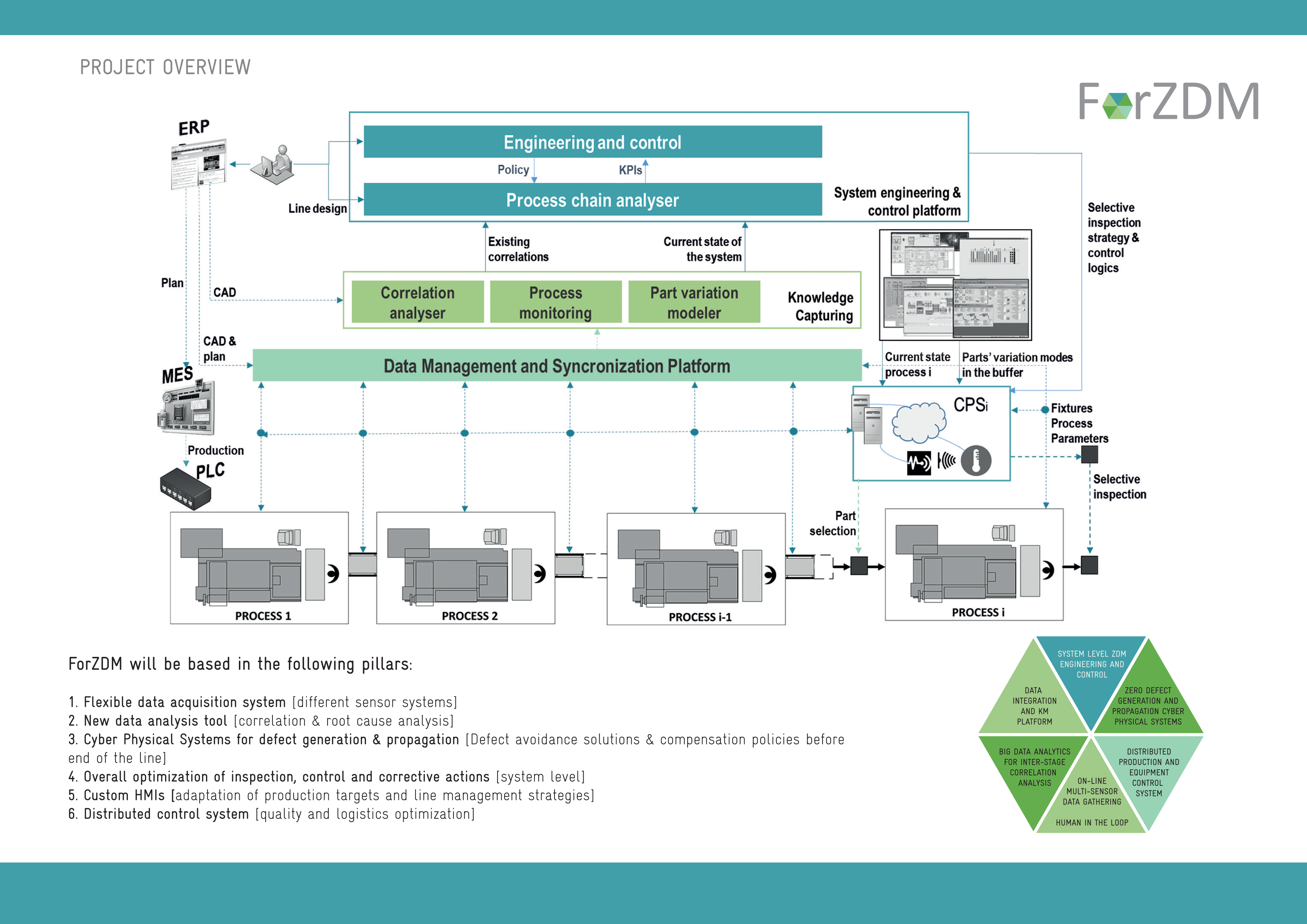
Visit the project web site
Spirit - Inspection Robots

SPIRIT aims to develop an “inspection skill” for robots that takes the step from programming of complex inspection tasks to configuring such tasks. This will substantially reduce the engineering costs when setting up inspection robots in industrial environments. The main result will be a software framework that consists of two parts. The “offline framework” handles such the model-based automatic coverage planning for complex parts and various image-based inspection processes as well as the automatic robot program generation. It will include a generic interface to allow the easy exchange of process models (for different inspection technologies), of the CAD model of the part (for a different type of product to be inspected) or of the work-cell model (for a different kinematic structure). The generic “inline framework” deals with sensor data mapping to transfer 2D image data to the 3D object model. It will provide the backbone for the real-time execution of the actual inspection process, including the synchronization of data acquisition and robot motion.
Consortium: • PROFACTOR • IT+ROBOTICS • MARPOSS • INFRATEC GMBH INFRAROTSENSORIK UND MESSTECHNIK • UNIVERSITA DEGLI STUDI DI PADOVA • CENTRO RICERCHE FIAT • VOESTALPINE BOHLER AEROSPACE • FISCHER ADVANCED COMPOSITE COMPONENTS
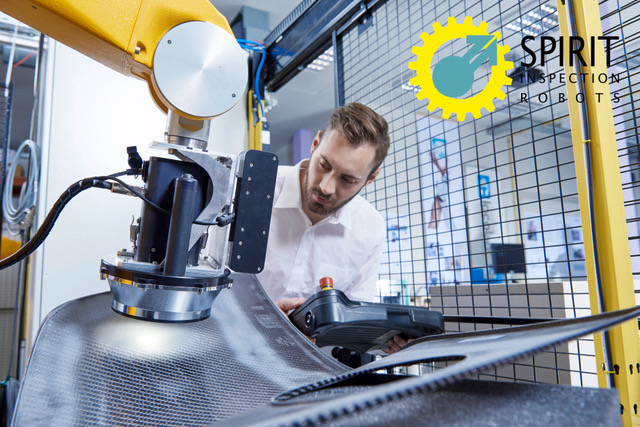
Visit the project web site
CRUISE - Cyber secuRity in Uas mIssions by satellitE link

All the aeronautical European development plans suggest a vast diffusion and application of remotely piloted aircrafts (RPAS) in many industrial areas, from land monitoring of specific areas to sensible zones patrolling. The integration of RPAS in a non-segregated airspace sets some real challenges related to cyber-attack risk assessment. Cyber-attacks to RPAS can affect operation safety and airspace safety or, in the worst hypothesis, they can seriously injure people and damage property. CRUISE’s intent is to design, develop and validate a CyberSec Test Range, a technological framework which is strictly linked to Gottaglie Airport, a center that already experiments RPAS and studies the integration of UAS in non-segregated airspace, a place where the overall assessment on vulnerability and resilience of UAS with respect to cyber-attacks can be led. The CyberSec Test Range will set up a combination of services combining ICT systems, SATCOM and SATNAV services aimed at evaluating the overall vulnerability of UAS, and this includes the analysis of flight platforms, on board avionics and payload sensors. Moreover, quality, consistency and integrity of data collected during VLOS, RLOS, BRLOS operations will be verified. The following categories of cyber-attacks will be subject to the examination:
• Hardware attacks – the hacker has direct access to the RPAS;
• Wireless attacks – the hacker uses wireless communication channels in order to attack command, control and communication systems;
• Sensor Spoofing – The hacker substitutes real data collected by the on-board sensors (i.e. receivers, vision, radar, sonar, LIDAR and IR sensors) with fake data.
• Hardware and software systems capable of realizing cyber-attacks on UAV simulator during air operation simulations (software in-the-loop)
• Hardware and software systems capable of realizing cyber-attacks in emulated air operations (hardware in-the-loop)
• Vulnerability analysis conducted through the actuation of real test flights in which data and information about cyber-attacks are sent to the Mission Integration and Verification System in order to develop a risk assessment report.
Consortium: • Planetek Italia • Distretto Tecnologico Aerospaziale • Leonardo •Aeroporti di Puglia • ENAV • Telespazio
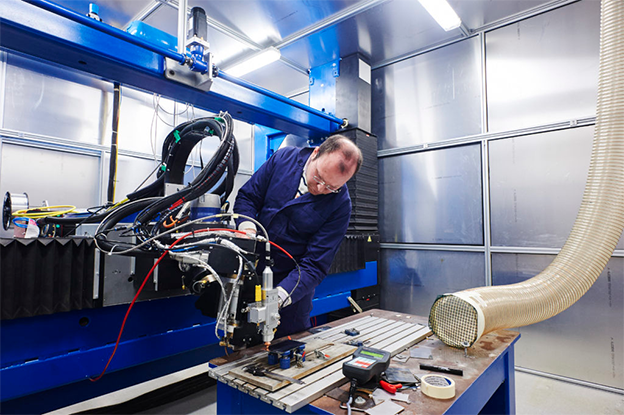
Visit the project web site
RPASinAir - Insertion of Remotely Piloted Aircraft System into non-segregated airspace for applications

The European RPAS Steering Group (ERSG) received in 2013 by the European Commission the mandate to establish a Roadmap for the safe integration of civil RPAS into the European aviation system. The research study conducted up to now will finish briefly its activity, publishing the regulation by EASA; this will get under way the request of new services like airspace monitoring, territory monitoring, emergency and disaster monitoring, industrial services. To enable and catch this pushing request, the aerospace industry has to enhance safety and efficacy performances of the RPAS, has to integrate them in the airspace and has to introduce new sensors and technologies for integrated data analysis. The RPASinAir project will develop knowledge and solutions in three technological fields strictly linked, enabling innovative services for the monitoring and control of the territory by RPAS and satellite Earth Observation: 1) design and planning of air mission, developing architecture and SW modules for the full-scale simulation of missions of one (or more) RPAS with 2d/3d visualisation within the air traffic; 2) Air Traffic Control, developing new ATM/C protocols, techniques, systems and interfaces to visualise the air traffic and communicate with the pilot on the ground 3) Innovative sensors and technologies, and systems for data analysis, developing sensors for the monitoring of new risk factors (cryospheric, fire dust…), the relevant signal processing techniques, and a system for real and near real-time multisource analysis (air payloads, satellite data, in situ measurements), aiming at the identification of alert states. The solutions converge into a demonstration, implemented in Apulia (Grottaglie airport, the INFN/UNIBA’s ReCaS infrastructure), including both the design and execution of various RPAS flights controlled by the ATM/C and the validation of the innovative sensors and of the multisource analysis systems. The RPASinAir project enhances the safety of the air transports, expanding the innovative and investment attracting capabilities of the Apulian and national aerospace industry, and satisfies the fast growing European market, causing then an increase of the local employment with high-profile technological skills.
Consortium: • Distretto Tecnologico Aerospaziale • ENAV • Telespazio • Università di Bari • Vitrociset • Aeroporti di Puglia • Università Kore di Enna • Istituto nazionale di fisica nucleare • Leonardo • Centro nazionale delle ricerche • ENEA • Planetek • EnginSoft • Politecnico di Bari
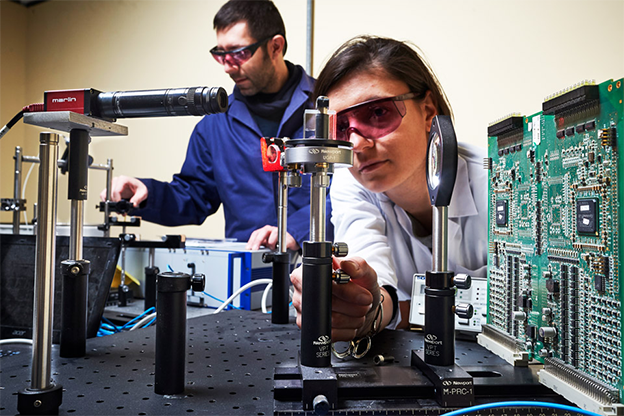
Visit the project web site
FLET4.0 - FLEet managemenT optimization through I4.0 enabled smart maintenance

The project proposes the development of innovative methodologies for maintenance processes of complex engineering systems, based on intelligent data processing that can be detected by intelligent technology enabling technologies. Applications are maintenance of aircraft fleets, aeronautical systems, rail systems and applications to satellite systems. The main objectives for the Aero domain concern the development of iterative algorithms and software to define the engine removal plan and its maintenance work, optimizing engine availability at the customer and maintenance costs, as well as obtaining a procurement plan of integrated parts with planning of interventions and the implementation of a maintenance strategy. Strategic support is provided by universities for methodological aspects and the involvement of SMEs in process design and the development of algorithms and SW. For the railway domain, enabling enablers will be developed for operators involved in maintenance, by developing tools to support non-traditional approaches (eg increased reality, reverse engineering) for remote maintenance of railway vehicles and optoelectronic systems for railway infrastructure measurement. Thanks to the IoT technologies, we will use the available data and will return the information (eg processing sequences) to the production system. Graphics and video content will be used to optimize man-machine interaction in maintenance processes. The analysis of telemetry flows of aerospace missions is currently on a daily basis with team of engineers analyzing the packets that the satellite produces with continuity and discharge in its visibility passes on Earth stations. This determines some criticalities depending on the sensitivity to the amount of data available (GB order per mission per day), that makes it impossible for an operator to appreciate all possible correlations as well as the relationships between the business cycle (day / night, weekend, holidays) and satellite-station contacts: delayed alarms are possible, due to the temporary absence of operators, or the need for expensive shifts over the 24 hours. A system will be developed that displays alarms and ordered lists of controls based on identified anomalies.
Consortium: • DTA - Distretto Tecnologico Aerospaziale • EKA • MER MEC • Politecnico di TORINO
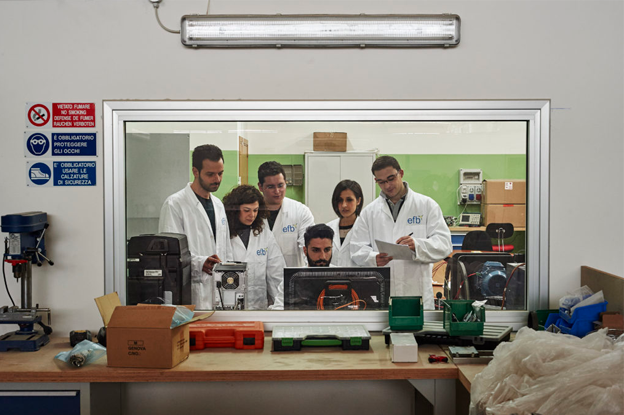
Visit the project web site
SmartBench – a SMART Industrial Safety WorkBENCH
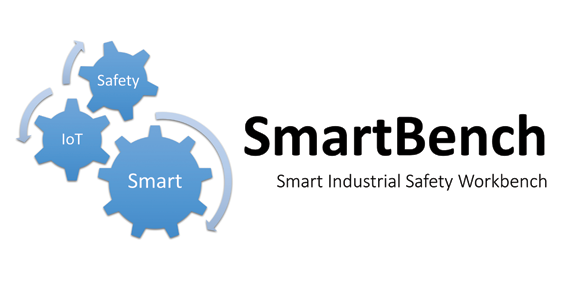
Risk management in industrial systems with a high level of complexity must balance both operational interventions - aimed at restoring the desired state and / or implementing early warning actions - and cognitive interventions, which instead aim to provide the operator with a constantly updated picture of the assets and the criticality of the plant. These activities traditionally require a high level of resource use by plant operators and by control bodies. The Internet of Things (IoT) approach, which makes it possible to acquire, process and transmit data automatically, is emerging as mainstream technology in many sectors and has still unexplored potential for job safety. The SmartBench research project (www.smartbench-project.it) aims to exploit for safety purposes the technologies, going under the name of "Industry 4.0", that are making the new industrial revolution possible. This is made possible by rethinking safety by exploiting all the technological potentialities available today and consequently increasing the safety of workers to a level never seen before. The overall goal of SmartBench is to introduce a technological change in job safety in an integrated fashion. Different tools must be synchronized to this end: networks of Acoustic Emissions (AE) sensors for a continuous monitoring of the structural health of components, smart tags to manage work equipment and facilities, virtual simulation of ageing of structures, and internet of things (IoT) to assess the personnel health state and the proper use of the protective equipment. The SmartBench project involves different Italian partners: the University of Rome “Tor Vergata”, the University of Rome “Campus Bio-Medico”, the University of Bologna “Alma Mater Studiorum”, the University of Salento and the University of Messina as academic foundations. INAIL, the Italian public body of job insurance, rounds out the group.
Consortium: • Inail - Istituto Nazionale Assicurazione contro gli Infortuni sul Lavoro • University of Rome Tor Vergata • University of Rome Campus Bio-Medico • University of Bologna Alma Mater Studiorum • University of Salento • University of Messina
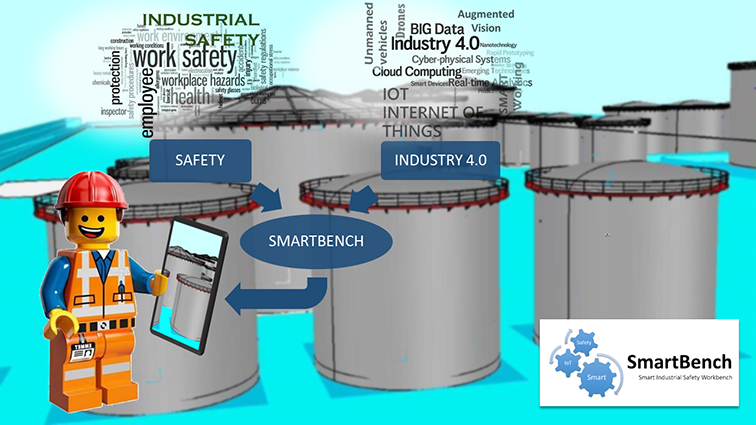
Visit the project web site
KETGATE - Central European SME Gateway to Key-enabling Technology Infrastructures - Sparking a new Transnational KET Innovation Ecosystem
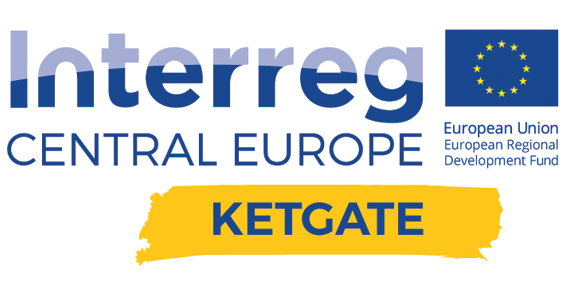
KETGATE is an Interreg Central Europe project that focuses on the innovation and competitiveness of SMEs. KETGATE aims to facilitate the transnational cooperation between SMEs and Research and Technology Organizations (RTOs), and to improve the access of Key Enabling Technologies (KETs) for SMEs.
Consortium: • Upper Silesian Agency for Entrepreneurship and Development • Veneto Innovazione • National Cluster Association • Steinbeis-Europa-Zentrum • TERA Tehnopolis • Institute Jožef Stefan • Joanneum Research Forschungsgesellschaft • Bay Zoltan Nonprofit for Applied Research
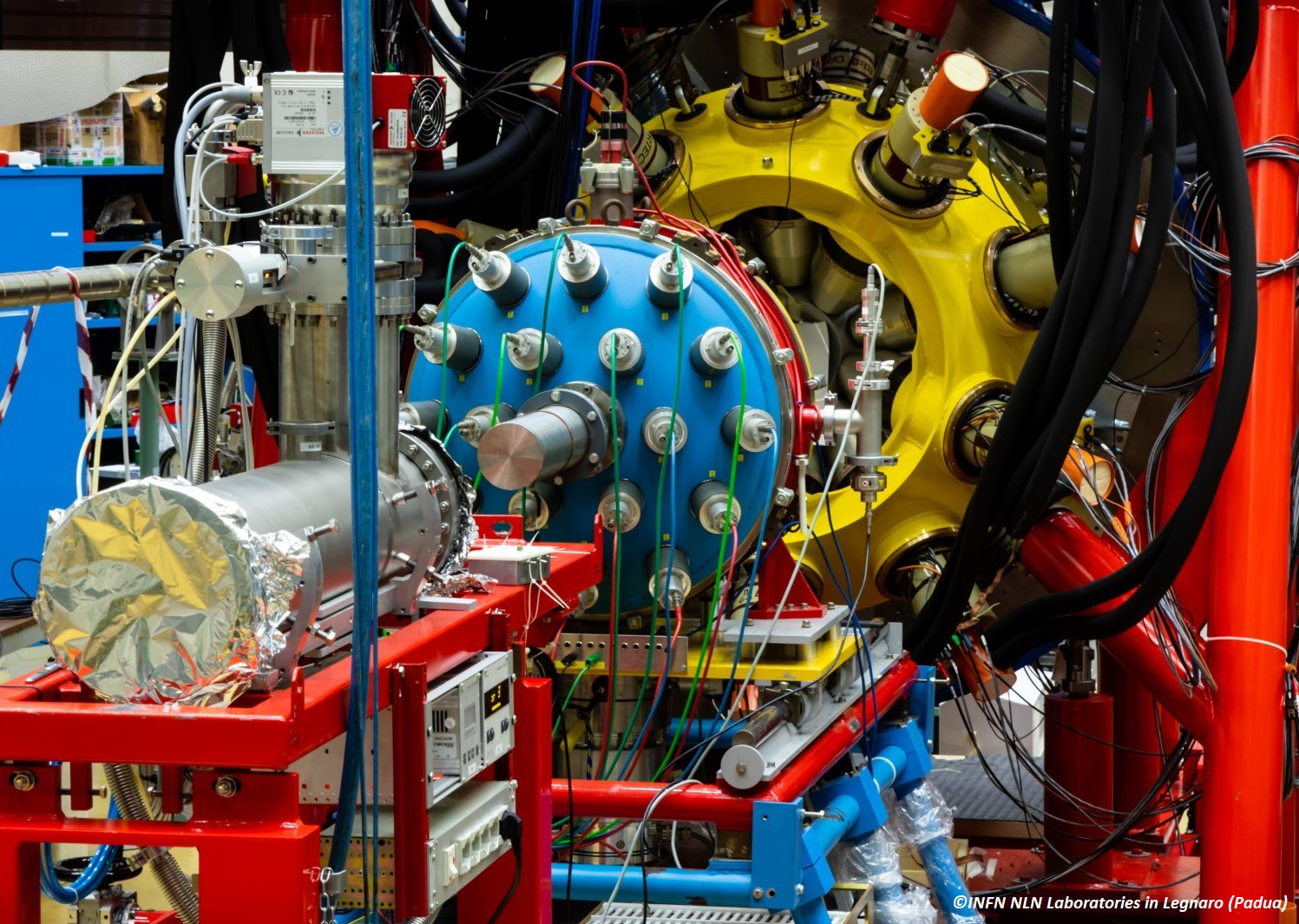
Visit the project web site
InnoPeer AVM - PEER-to-peer network of INNOvation agencies and business schools developing a novel transnational qualification programme on AdVanced Manufacturing for the needs of Central European SMEs
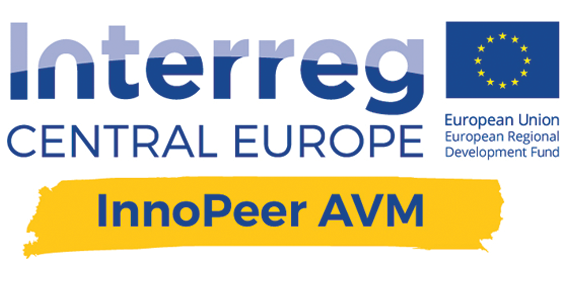
InnoPeer AVM is an Interreg Central Europe project that means to develop and test a first comprehensive, transnational AVM qualification programme, shaped to the needs of central European companies. Participants attending the project’s teaching cases will become InnoPeer-certified AVM managers.
Consortium: • Fraunhofer Research Institution for Casting, Composite And Processing Technology • WrocŁaw University of Science and Technology • Cluster Mechatronik & Automation Management • Pannon business Network Association • Veneto Innovazione • Business Upper Austria • Democenter-Sipe Foundation • Bundeswehr University Munich • University of Sopron • Institute for Work Research And Work Policy at Johannes Kepler University Linz • Department on management and Engineering (DTG) - University of Padova
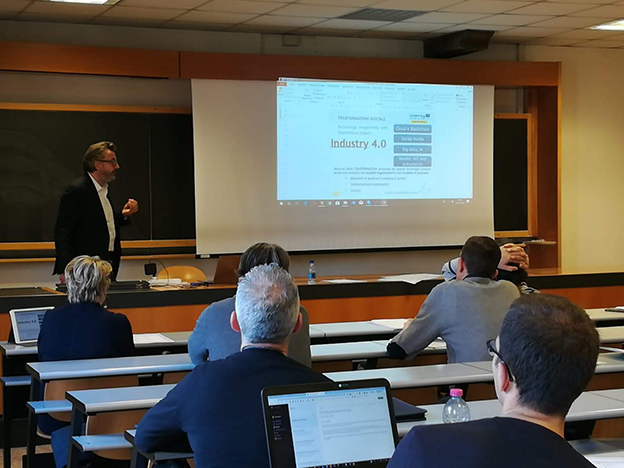
Visit the project web site
HyMAN - Hybrid manufacturing strategies through selective laser sintering for the customization of series components

Aim of the project is the development of an innovative hybrid production process for metallic mechanical components with customization requirements: parts which integrate a primary frame obtained by conventional machining with a secondary structure, additively deposited by powder-bed fusion. With a view of an estensive application of the process in the tooling production, automotive market as well as creative industries, a hybrid biomedical device for implant restorations, in titanium or Co-Cr, was manufactured to a functional prototype level.
Consortium: • 3Dfast • CNA Confederazione Nazionale dell'Artigianato e della Piccola e Media Impresa • NTNU Norwegian University of Science and Technology • SINTAC • Biomedical Engineering • Sweden & Martina
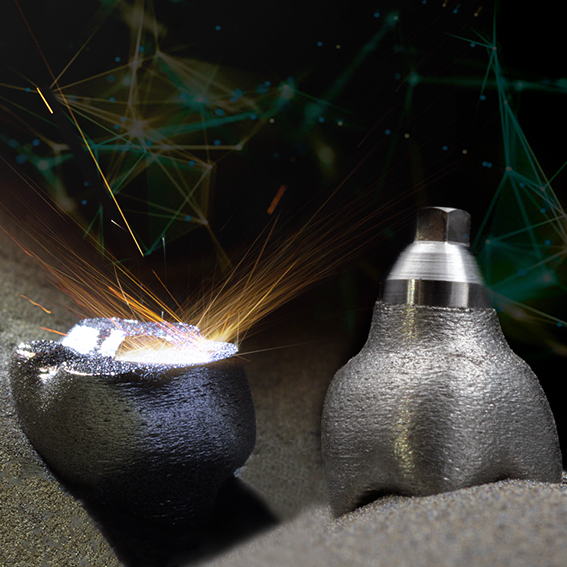
ODIN - CAD/CAE Integration in Orthodontics Devices Innovation

Aim of this project is to develop new functional appliance for the correction of class II skeletal malocclusion through a systematic design methodology, the most innovative CAE tools and manufacturing techniques. Considering the 3D models of the patient craniofacial and dental structures, a patient specific appliance model was designed allowing to better plan the orthodontic treatment. Also FEM and kinematic analysis are performed on the virtual model of the mounted device to evaluate the quality and reliability of the selected solution.
Consortium: • Università di Padova • Catholic University • Università di Udine • UCLA The University of California • MMD Medical Micro Design • Università di Milano
